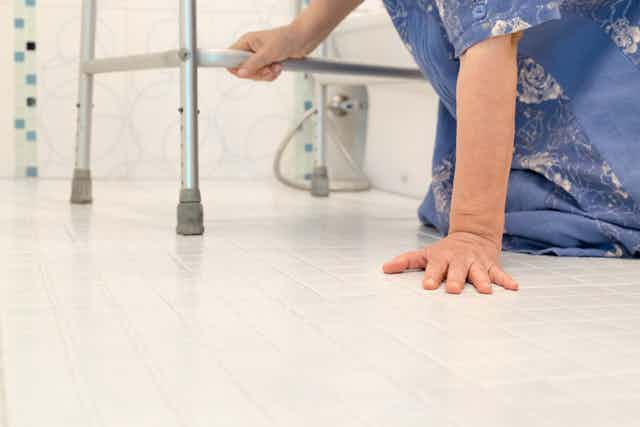This article is part of our series on older people’s health. It looks at the changes and processes that occur in our body as we age, the conditions we’re more likely to suffer from and what we can do to prevent them.
As the world’s population lives longer, the significance of osteoporosis and fractures increases.
In Australia, it is estimated that 4.74 million Australians aged over 50 have osteoporosis, osteopenia (less severe than osteoporosis) or poor bone health. By 2022, it’s estimated this will increase to 6.2 million, with one fracture occurring every 2.9 minutes.
In 2012, the total cost of poor bone health in adults aged over 50 was A$2.75 billion, and 64% of this cost was directly associated with treating and managing fractures.
What is osteoporosis?
Osteoporosis is a condition in which bones become fragile and brittle, leading to higher risk of breakage. This occurs when bones lose minerals such as calcium more quickly than the body can replace them.
In Australia, osteoporosis affects one in three women and one in five men over the age of 50.
Referred to as a “silent” disease, osteoporosis generally has no symptoms and is rarely diagnosed until bones break or fracture. Osteoporosis is the disease and fractures are the outcome we are trying to prevent.
Why do we get osteoporosis as we age?
Our bones are living tissue and are in a continual state of renewal. As we age, more bone is broken down (resorbed) than is replaced by new bone. Thus our bones get thinner and more fragile as we age. This is particularly true during menopause for women and in men with lower levels of sex steroid hormones such as testosterone.
“Primary osteoporosis” is bone loss that can be attributed to ageing or the known hormonal consequences of ageing, such as the decline in oestrogen and testosterone. These hormones help regulate bone renewal that occurs naturally as we age.
As the level of these hormones decline from about the age of 50 in women and around 60 in men, the rate of bone breakdown is faster than the growth of new bone to replace it. Over time this leads to weaker, thinner bones. In women, the risk abruptly increases from the time of menopause, coinciding with a significant drop in circulating levels of oestrogen.
“Secondary osteoporosis” occurs as a consequence of another disease (such as coeliac disease with associated calcium malabsorption), or as an adverse consequence of therapy for another disease where medication might bring it on.
Thin bones of a poorer quality structure are more likely to break. The vast majority of fractures occur as a result of a fall from standing height. Vertebral or spinal fractures are the exception, frequently occurring without a fall or significant “trigger event”.

Why do we fall over when we get older?
There are many reasons older adults are susceptible to falls. These include side effects of some medications, vision impairments and less ability to prevent tripping over as balance, muscle mass and strength decline with age.
The risk of fracture due to poor bones increases with age, and this is further enhanced by osteoporosis.
Genetics also plays a role in an individual’s risk of fracture. Those of us with parents who had a hip fracture have an increased risk of fracture. The most common sites of fracture in older adults are the hip, vertebrae or spine, wrist or the humerus (upper arm or shoulder).
About 30% of older adults fall at least once a year. The less often you fall, the less likely you are to break a bone.
People aged 70 and over accounted for 70% of the total acute hospital inpatient costs in 2012. Hip fractures impose the highest burden both in terms of cost and decline in health-related quality of life.
Results from a recent study show most fracture patients have not fully recovered their previous level of quality of life by 18 months after the fracture.
Preventing osteoporosis and falls
Preventing falls in older people is an important way to prevent fractures. Adults who have good balance and muscle strength are often able to “save themselves” when they trip. Exercises that improve balance (such as Tai Chi) and help maintain muscle mass (weight-bearing and resistance exercises) are beneficial.
Preventing osteoporosis involves regular weight-bearing and resistance exercise, adequate calcium in the diet (at least three serves of dairy or equivalent per day) and an adequate level of vitamin D in the bloodstream.
Sunlight exposure on the skin is the primary source of vitamin D, but we need to practise safe sun exposure to reduce the risk of skin cancer. The recommendations vary by skin type, latitude and season. For people with moderately fair skin, six to seven minutes before 11am or after 3pm during summertime is considered sufficient.
During wintertime, the daily recommended sun exposure increases to between seven and 40 minutes depending on where you live in Australia.
While lifestyle factors such as nutrition and exercise can make an important difference to bone health over time, if an older adult has several risk factors for fracture their doctor may discuss the benefits of “bone active” medication. These medications slow the rate bone breaks down as we age. In general these medications halve the risk of fracture and are much more effective than lifestyle measures alone.
Read other articles in the series here.

